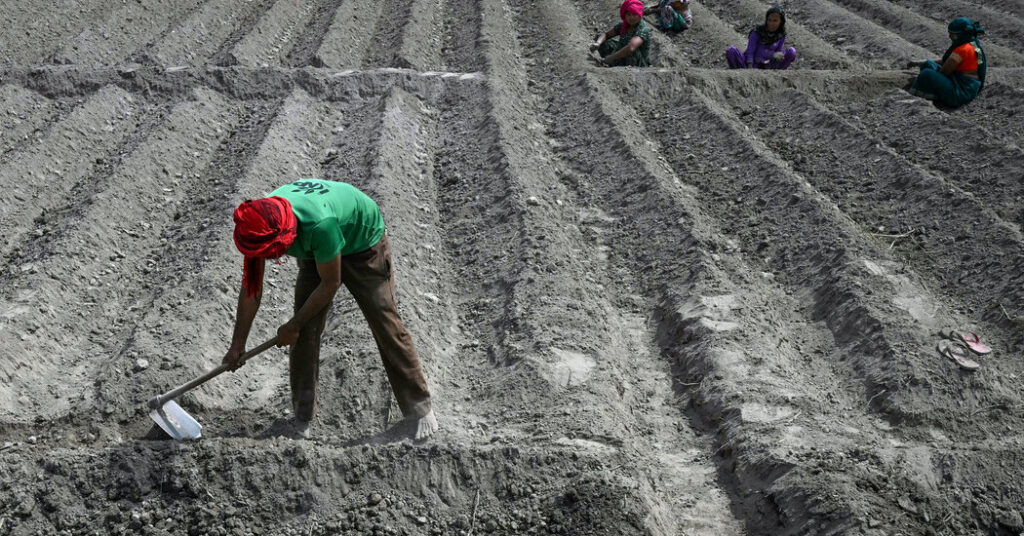The world's most populous country, India, is also one of the most vulnerable to climate disasters, not just because of heat and floods exacerbated by global warming, but also because many of its 1.4 billion people are vulnerable to it in the first place: Most of them are poor by global standards and have no safety net.
Early results from Tuesday's election suggested the party led by Hindu nationalist two-term Indian prime minister Narendra Modi is on track to win the most seats in India's parliament but may need to team up with smaller parties to form a coalition government.
The government will face major challenges posed by climate change.
Heat has literally become an election issue.
The six-week voting process took place amid scorching heat in several parts of the country, with at least 33 people, including poll workers, dying from heat-related complications in the northern states of Bihar and Uttar Pradesh last week, Reuters reported, citing government officials.
Rohit Magotra, deputy director of the Integrated Research and Action for Development, urged the National Election Authority to reschedule future elections to avoid such tragedies. Magotra noted that not only were party workers from all parties suffering from the heat, but so were voters who had to queue in the sun.
“We are definitely seeing momentum building and it's unlikely we'll see elections in mid-summer going forward,” said Magotra, whose group advocates for heat policies in Indian cities.
The Election Commission set up a task force to monitor weather conditions after voting began this year amid unusually high temperatures, and sent election staff a heat-preparedness list compiled by the National Disaster Management Authority. But according to a report in the Indian news site Scroll, party canvassers were not told to do anything special because of the heat.
Parliamentary elections in India are traditionally scheduled in the summer, but climate change is making those summers more dangerous. This year, one weather station in Delhi recorded a record high of more than 52 degrees Celsius (127 degrees Fahrenheit) in late May. Scientific studies of heatwaves have shown that India has experienced three consecutive years of unusually high temperatures, all of which have been exacerbated by climate change.
Some cities and states have heat action plans, at least on paper, but as an independent analysis concluded last year, most of them are underfunded and lack concrete ways to identify and protect the most vulnerable.
The politically powerful farmers are angry.
The Modi government is facing some of the strongest opposition from farm groups in recent years, and many of their concerns are rooted in climate issues.
Their agitation reflects a deep downturn in agriculture, a major part of India's economy. More than half of India's people depend on farming for their livelihoods. Many key agricultural regions are running out of groundwater. Farmers in many parts of the country are deeply indebted.
On top of that, crops have been destroyed many times in recent years by extreme weather and unpredictable rains.
In 2020, hundreds of thousands of farmers from India's breadbasket states of Punjab and Haryana camped out on the outskirts of New Delhi and drove tractors into the capital in protests that turned violent. The initial complaints were directed at Modi's push for more private investment in agriculture, which farmers said would make them more vulnerable to low prices driven by corporate profit-mongering.
The government's concessions in the face of violence, a rare move for Prime Minister Modi, also show how seriously his administration is taking the protests.
Farmers have again marched to the capital this year, this time demanding that the government increase the prices of wheat and rice.
India's global image is often associated with a fast-growing economy, vibrant cities, and a huge young workforce. But the majority of India's people still depend on agricultural income, most of its 770 million poor people live in rural areas, and the government has done little to create the off-farm jobs needed by its burgeoning young population. Rebuilding agriculture in an era of climate change is likely to be one of Modi's most significant challenges in the coming years.
“Arguably, the increase in extreme weather events – floods, heat waves, storms – is the most significant climate issue facing the government,” said M. Rajeevan, a former secretary in the ministry of earth sciences and now vice chancellor of Atria University in Bangalore.
Then there is India's coal habits.
Climate change is primarily caused by the burning of fossil fuels, the most polluting of which is coal.
Prime Minister Modi has emphasized the promotion of renewable energy infrastructure at international summits, but at the same time, his administration continues to expand coal-fired power generation.
This is due to both political and economic considerations. Coal is the fuel of the moment. Public and private companies, many of them politically connected, are investing in coal. Governments' main interest is to keep electricity prices low.
Coal remains the country's largest source of electricity, and coal use has risen this year, in part due to climate change itself.
Rising temperatures will drive demand for air conditioners and electric fans, which will increase electricity demand. Emissions from India's power sector jumped in the first quarter of 2024, according to Ember, a research institute that tracks emissions.
More than 70% of India's electricity comes from coal, with solar and wind accounting for just over 10%. The government has set an ambitious goal of generating 500 gigawatts of renewable energy by 2030, but coal's influence isn't likely to fade anytime soon. According to government projections, coal will still provide more than half of India's electricity in 2030.


